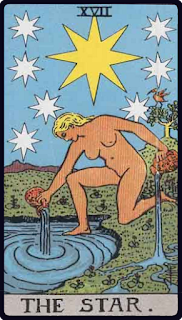
Where Temperance asked us to find balance between our emotions and our thoughts, to understand the difference between want and need, and to stride the conscious and unconscious mind in order to find discipline in our pursuit, the Star compliments this symbolism once more in turn representing the balance between conscious and unconscious desires.
Where Temperance asked us to show patience and understanding to the world around us and those within it, the Star is much more introverted and introspective. Here the focus is on self-improvement, navigation, counsel, and hope above all else.
In the upright state the Star asks us to look inward when we feel lost, and nourish our spirit with self-reflection. Whilst there are times to seek guidance from others, in the upright state this card represents the assertion that direction can be found from within, to know where we should go or what we should do next, we should look inward in an attempt to gain a greater understanding of our desires. When we find ourselves at one extreme of the scale, either completely content with our environment, or completely disaffected by it, we can find it hard to convince ourselves that we are capable of movement and experiencing anything other than the status quo; we can also convince ourselves through self-doubt that our torment and tantra are part of our identity and can’t be changed. This belief is ignorant to the reality of life, all things change in time, life ebbs and flows, and whether we are able to flow with it determines how much disruption is caused when the current shifts.
In the inverted state the Star asks us to seek the help of others in the pursuit of understanding our desires. It is important to make a distinction here, we are not asking others to give us direction, we are asking for insight that we can use to better understand ourselves so that we may make that choice.
If ever there was a card in the Major Arcana that would explicitly say “Go to therapy” then the inverted Star would be it. Whilst you do not have to take this direction literally, the symbolism remains the same, the perspective of others can grant us a deeper understanding of the self, we are therefore asked to seek out those external perspectives that can help us see aspects of ourselves that we are either unable or until now unwilling to see and confront.
In the Rider-Waite deck a woman is depicted echoing the Temperance card, she kneels with one foot in the body of water representing the unconscious mind, and her other knee resting upon the land representing the conscious mind. Two jugs mirroring the chalices of the archangel Cassiel as depicted in Temperance can be seen, here the woman decants their water representing her attempt to nourish both elements of the mind.
Above the woman can be seen a single golden star representing direction and navigation it holds 8 points that mirror the rose of a compass, about this central star can be seen seven white stars representing the seven archangels who watch over the woman below. In the background a single tree can be seen atop a hill with an Ibis bird perched upon it, borrowing from Egyptian symbolism the Ibis represents Thoth the God of Learning and Wisdom and reinforces the introspective element of self-reflection in the pursuit of greater understanding.
In self-reflection the Star can serve as a prompt to consider the sources and influences in your life that help provide you with direction. When you are confused or feeling lost and disoriented, where do you turn to, whose counsel do you depend on, whose knowledge and experience do you draw upon, or in instances where we have a high level of independence, what past mentality do you revert to when you can’t process in the moment that which is overwhelming?
Where the High Priestess put particular emphasis on recognising what we know, what we have experienced, and what others come to us for when seeking counsel, the Star asks us to recognise who and what we turn to when we seek to do the same for ourselves.
These questions prompt introspection and self-reflection in an attempt to understand what determines our direction and if we feel directionless, why those determining factors have not served their purpose in this case and to recognise whose wisdom or what source of strength we turn to that is external to ourselves when we can’t satisfy that need.
Ask yourself “Who do I turn to?” or “What do I turn to?” when you feel this way, and ask “What do I gain from them, how does that help me find direction?”
In cases of extreme isolation, we may only have ourselves to turn to, in those cases we should ask how we can form a connection to someone or something that can guide us. This should not be a choice we pursue out of the desire to create co-dependency but rather a choice we pursue in recognition of the limit of our own capability and acknowledgement of the hurdles we face.

No comments:
Post a Comment
All comments are moderated before they are published. If you want your comment to remain private please state that clearly.